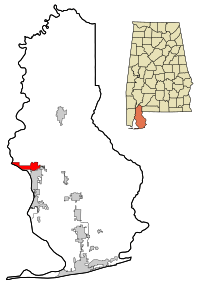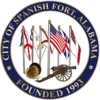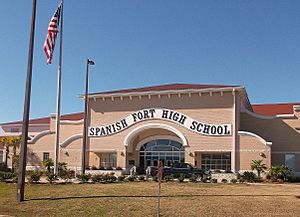Spanish Fort, Alabama facts for kids
Quick facts for kids
Spanish Fort, Alabama
|
|||
|---|---|---|---|
|
|||
| Motto(s):
A City of Spirit!
|
|||

Seal of the City of Spanish Fort, Alabama
|
|||
| Country | United States | ||
| State | Alabama | ||
| County | Baldwin | ||
| Area | |||
| • Total | 35.73 sq mi (92.53 km2) | ||
| • Land | 31.02 sq mi (80.34 km2) | ||
| • Water | 4.71 sq mi (12.19 km2) | ||
| Elevation | 23 ft (7 m) | ||
| Population
(2020)
|
|||
| • Total | 10,049 | ||
| • Density | 323.96/sq mi (125.08/km2) | ||
| Time zone | UTC-6 (Central (CST)) | ||
| • Summer (DST) | UTC-5 (CDT) | ||
| ZIP codes |
36527, 36577
|
||
| Area code(s) | 251 | ||
| FIPS code | 01-71976 | ||
| GNIS feature ID | 1669449 | ||
Spanish Fort is a city in Baldwin County, Alabama, in the United States. It is located on the eastern shore of Mobile Bay. In 2020, about 10,049 people lived there. Spanish Fort is a nearby town to Mobile and is part of the larger Daphne-Fairhope-Foley metropolitan area.
Contents
What is the History of Spanish Fort?
The history of Spanish Fort goes back a long way, to 1712. That's when the city of Mobile was started by Jean-Baptiste Le Moyne de Bienville from France. Spanish Fort began as a trading post set up by the French.
Early History and Wars
After the French and Indian War, a big area on the Gulf Coast, including the trading post, was given to the British in 1763. During the American Revolutionary War, the Spanish took over Mobile. They built a military fort, called a presidio, where the old trading post used to be. This "Spanish Fort" was attacked by British forces in 1781, but the British were stopped. After a treaty, Spanish Fort officially became part of the United States.
Spanish Fort During the Civil War
During the American Civil War, Spanish Fort was made very strong. It was an important defense for the city of Mobile from the east. Many forts, like Fort Huger and Old Spanish Fort, were part of these defenses.
After the Union army won the Battle of Mobile Bay, Mobile was still held by the Confederates. In early 1865, Union forces started a land attack to take Mobile. Spanish Fort was the site of the Battle of Spanish Fort. When Spanish Fort fell, Union forces could then focus on Fort Blakeley to the north. This helped them defeat the last organized resistance east of the Mississippi River. After Spanish Fort and Fort Blakeley fell, Union troops could enter Mobile without a fight.
Modern Growth and Development
Spanish Fort officially became a city on July 19, 1993. Since then, it has grown a lot. A large outdoor shopping center called Eastern Shore Centre opened in 2004. Spanish Fort Town Center also helped the city grow with more shops and businesses.
In 2012, work began on the new Spanish Fort Community Center. Even with some delays from rainy weather, the city staff moved into the new building in September 2015. This center has the city library, offices for the mayor and other city services. The building is about 30,000 square feet and cost around $5 million to build. It sits on 17 acres of land and has a large pond with fountains. The city also holds community events and important meetings there.
Where is Spanish Fort Located?
Spanish Fort is located at 30°40'7.403" North and 87°55'19.844" West. It sits above the east shore of the Blakeley River, where it flows into Mobile Bay.
You can get to Mobile from Spanish Fort using U.S. Routes 90 and 98 (Battleship Parkway). These roads cross the Mobile River and lead about 9 miles to Mobile. Interstate 10 also passes just south of Spanish Fort. You can get on Interstate 10 from exits 35 and 38. It also leads west across Mobile Bay to Mobile.
The U.S. Census Bureau says that Spanish Fort covers a total area of about 86.5 square kilometers (33.4 square miles). About 74.3 square kilometers (28.7 square miles) of this is land, and 12.2 square kilometers (4.7 square miles) is water.
What About Education in Spanish Fort?
Spanish Fort is part of the Baldwin County Public Schools system. The superintendent, Eddie Tyler, leads this system.
There are three elementary schools, one middle school, and one high school that serve students in Spanish Fort. As more students have moved to the area, the high school and Rockwell Elementary School have added new buildings. The County Commission approved a $60 million loan to help fund these additions across the county. This also helped open Stonebridge Elementary School in 2022.
Schools in Spanish Fort
- High School
- Spanish Fort High School (Grades 9-12)
- Middle School
- Spanish Fort Middle School (Grades 6-8)
- Elementary Schools (Grades K-5)
- Spanish Fort Elementary School
- Rockwell Elementary School
- Stonebridge Elementary School
How Many People Live in Spanish Fort?
| Historical population | |||
|---|---|---|---|
| Census | Pop. | %± | |
| 1970 | 2,364 | — | |
| 1980 | 3,415 | 44.5% | |
| 1990 | 3,732 | 9.3% | |
| 2000 | 5,423 | 45.3% | |
| 2010 | 6,798 | 25.4% | |
| 2020 | 10,049 | 47.8% | |
| U.S. Decennial Census 2013 Estimate |
|||
In 2010, there were 6,798 people living in Spanish Fort. There were 2,861 households, with 1,910 of them being families. About 29% of households had children under 18.
In 2020, the population of Spanish Fort, Alabama, grew to 10,049 people. There were 3,278 households and 1,946 families. This was a 47.8% increase in population from 2010. Spanish Fort is now the second fastest-growing city in Alabama, right after Gulf Shores.
What is the Population Makeup?
Spanish Fort has a diverse population. Here's a look at the racial makeup from the 2020 Census:
| Race | Num. | Perc. |
|---|---|---|
| White (non-Hispanic) | 8,295 | 82.55% |
| Black or African American (non-Hispanic) | 610 | 6.07% |
| Native American | 46 | 0.46% |
| Asian | 179 | 1.78% |
| Pacific Islander | 7 | 0.07% |
| Other/Mixed | 491 | 4.89% |
| Hispanic or Latino | 421 | 4.19% |
How Do People Get Around in Spanish Fort?
The Baldwin Regional Area Transit System (BRATS) provides a special "dial-a-ride" service for people to get around the county. You can call them to arrange a ride.
See also
 In Spanish: Spanish Fort (Alabama) para niños
In Spanish: Spanish Fort (Alabama) para niños




